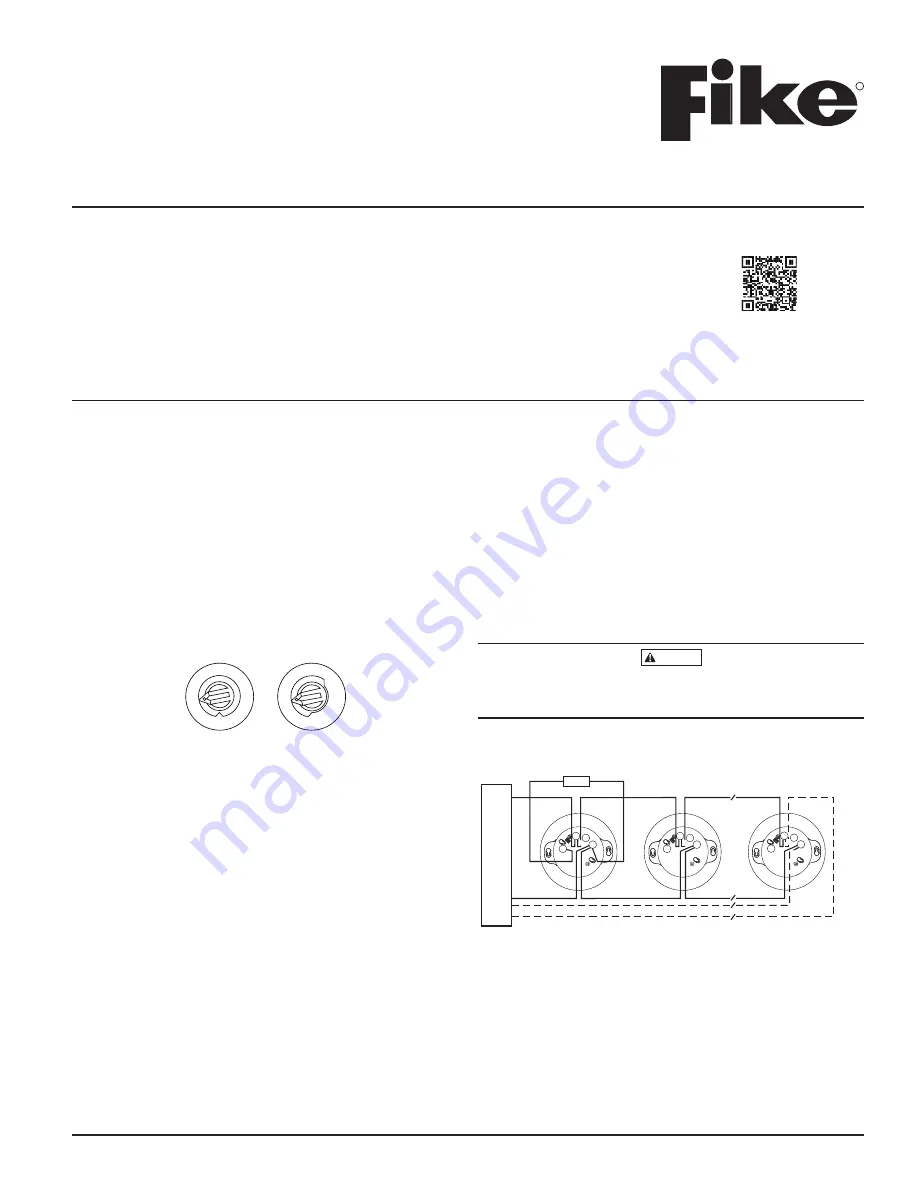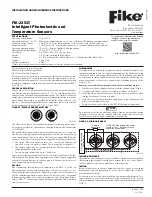
WIRING GUIDE
All wiring must be installed in compliance with the National Electrical Code,
applicable local codes, and any special requirements of the Authority Having
Jurisdiction. Proper wire gauges should be used. The installation wires should
be color-coded to limit wiring mistakes and ease system troubleshooting. Im-
proper connections will prevent a system from responding properly in the
event of a fire.
Remove power from the communication line before installing sensors.
1. Wire the sensor base (supplied separately) per the wiring diagram, Figure 2.
2. Set the desired address on the sensor address switches, see Figure 1.
3. Install the sensor into the sensor base. Push the sensor into the base while
turning it clockwise to secure it in place.
4. After all sensors have been installed, apply power to the control panel and
activate the communication line.
5. Test the sensor(s) as described in the TESTING section of this manual.
CAUTION
Dust covers provide limited protection against airborne dust particles during
shipping. Dust covers must be removed before the sensors can sense smoke.
Remove sensors prior to heavy remodeling or construction.
FIGURE 2. WIRING DIAGRAM
2
3
1
2
3
3
1
2
1
(–)
(+)
+
-
UL Listed Compatib
le
Control P
anel
CAUTION: Do not loop wire under
terminal 1 or 2. Break wire run to
supervise connections.
CLASS A OPTIONAL WIRING
Remote
Annunciator
(–)
(+)
RA
+
–
+
RA
+
–
+
RA
+
–
+
C0129-10
TAMPER-RESISTANCE
Photoelectric and temperature sensors include a tamper-resistant capability
that prevents their removal from the base without the use of a tool. Refer to
the base manual for details on making use of this capability.
TESTING
Before testing, notify the proper authorities that the system is undergoing
maintenance, and will temporarily be out of service. Disable the system to
prevent unwanted alarms.
All sensors must be tested after installation and periodically thereafter. Test-
ing methods must satisfy the Authority Having Jurisdiction (AHJ). Sensors
offer maximum performance when tested and maintained in compliance with
NFPA 72.
UL 268 listed for Open Air Protection
UL268A listed for Duct Applications
UL 521 listed for Heat Detectors
This sensor must be installed in compliance with the control panel system
installation manual. The installation must meet the requirements of the Au-
thority Having Jurisdiction (AHJ). Sensors offer maximum performance when
installed in compliance with the National Fire Protection Association (NFPA);
see NFPA 72.
GENERAL DESCRIPTION
Models FIK-2351T is a plug-in type multi-sensor smoke sensor that combines
a photoelectronic sensing chamber and 135°F (57.2°C) fixed temperature heat
detector across addressable-analog communications. The sensors transmit an
analog representation of smoke density over a communication line to a control
panel. Rotary dial switches are provided for setting the sensor’s address. (See
Figure 1.) The intelligent photoelectric and temperature sensors also transmit
an alarm signal due to heat at 135°F (57.2°C) per UL 521.
FIGURE 1. ROTARY ADDRESS SWITCHES
TENS
ONES
9
10
11
12
13
14
15
8
7
6
5
4
3
2
1 0
9
8
7
6
5
4
3
2
1 0
C0162-00
Two LEDs on the sensor are controlled by the panel to indicate sensor status.
An output is provided for connection to an optional remote LED annunciator
(P/N RA100Z).
Fike panels offer different feature sets across different models. As a result, cer-
tain features of the photoelectric and temperature sensors may be available on
some control panels, but not on others. These devices support Fike IDP mode
systems. The possible features available if supported by the control panel are:
1. The sensor’s LEDs can operate in three ways—on, off, and blinking–and
they can be set to red, green, or amber. This is controlled by the panel.
2. The remote output may be synchronized to the LED operation or con-
trolled independent of the LEDs.
3. Devices are point addressable up to 159 addresses.
Please refer to the operation manual for the UL listed control panel for spe-
cific operation. The photoelectric and temperature sensors require compatible
addressable communications to function properly. Connect these sensors to
listed-compatible control panels only.
SPACING
Fike recommends spacing sensors in compliance with NFPA 72. In low air
flow applications with smooth ceilings, space sensors 30 feet apart (9.1 m).
When using the photoelectric and temperature sensors as a heat detector in
FM3210 compliant applications, space sensors 20 feet apart (6 m). For specific
information regarding sensor spacing, placement, and special applications,
refer to NFPA 72 or the System Smoke Detector Application Guide, available
from System Sensor.
I56-6633-000
INSTALLATION AND MAINTENANCE INSTRUCTIONS
R
704 SW 10th Street
Blue Springs, MO 64015
Phone: 816.229.3405; Fax: 816.228.9277
www.fike.com
FIK-2351T
Intelligent Photoelectric and
Temperature Sensors
SPECIFICATIONS
Operating Voltage Range:
15 to 32 VDC
Operating Current @ 24 VDC: 200 uA (one communication every 5 sec. with green LED blink on communication)
Maximum Alarm Current:
2 mA @ 24 VDC (one communication every 5 seconds with red LED solid on)
Maximum Current:
4.5 mA @ 24 VDC (one communication every 5 seconds with amber LED solid on)
Operating Humidity Range:
10% to 93% Relative Humidity, Non-condensing
Operating Temperature Range: 32°F to 115°F (0°C to 47°F)
Air Velocity:
0 to 4000 ft./min. (0 to 1219.2 m/min.)
Height:
2.0˝ (51 mm) installed in B300-6 Base
Diameter:
6.2˝ (156 mm) installed in B300-6 Base; 4.1˝ (104 mm) installed in B501 Base
Weight:
3.4 oz. (95 g)
Isolator Load Rating:
0.0063*
*Please refer to your isolator base/module manual for isolator calculation instructions.
http://www.fike.com/06-912
For system/product documentation including
installation, operation, and maintenance,
scan QR code or enter URL provided.
1
I56-6633-000
1/15/2021




















